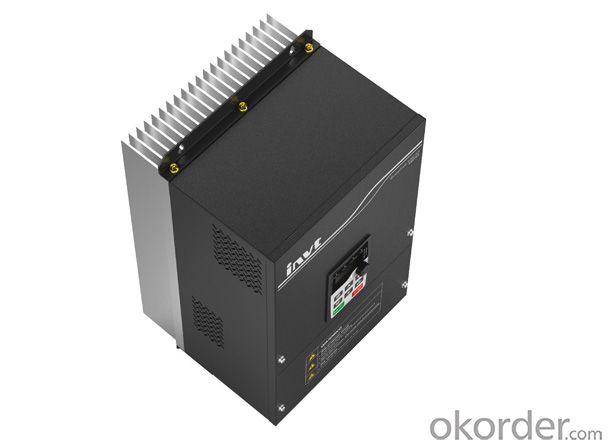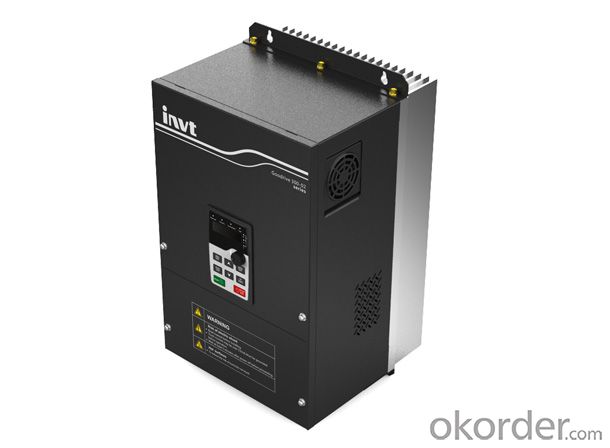Goodrive300-02 Flange-Mounting Drive with full certificate
- Loading Port:
- China main port
- Payment Terms:
- TT OR LC
- Min Order Qty:
- 100 pc
- Supply Capability:
- 10000 pc/month
OKorder Service Pledge
OKorder Financial Service
You Might Also Like
Goodrive300-02 Flange-Mounting Drive with full certificate
Specification
By the design of flange-mounting structure, Goodrive300-02 inverter, a special product developed according to the application features of textile industry, can effectively avoid foreign objects such as cotton fiber, dust and oil causing secondary pollution to the inverter and improve the temperature in the electrical cabinet and air ducts.
Goodrive300-02 inverter uses the design against cotton fiber blockage and it can run reliably for a long term at the high temperature of 50℃.
Futures
Flange-mounting will avoid external cotton fiber, dust and oil causing secondary pollution;
Based on the application features of textile industry, the special design of cooling structure can prevent cotton fiber from covering and blocking the radiator; the fans of electrical circuit are easy to clean and replace;
Metal casing design for all series adopts aluminum radiator in large size, so the inverter can run reliably for a long term at the environment temperature of 50℃;
All series support common DC bus;
Nonstop function at instantaneous power loss;
Standard MODBUS communication, optional Profibus-DP, CANopen and Ethernet communication.


FAQ:
Q: Do you have the CE, TUV, UL Certification?
A: We’ve already passed all the tests, and any certificate is available.
Q: Have you ever sold your products to companies in my country?
A: Of course, we have customers in all general PV markets, but I think we should expand our market share along with the market growth.
Q: When did your company set up? You are a new company, how can I believe your quality?
A: We entered into Solar PV industry in 2005, now we have several plants in manufacturing of a-Si and c-Si panels, and our capacity is 220MW per year. Till now we have already passed all the tests by authorized laboratories, e.g. TUV, CE, UL.
Q: Can you help us install the module if we cooperate with you?
A: We haven’t entered into installation sector, but we have the plan in near future.
Q: How do you pack your products?
A: We have rich experience on how to pack the panels to make sure the safety on shipment when it arrives at the destination.
Q: Can you do OEM for us?
A: Yes, we can.
Q: Can we visit your factory?
A: Surely, I will arrange the trip basing on your business schedule.
- Q:Can a solar inverter be used with a solar-powered air conditioner?
- Yes, a solar inverter can be used with a solar-powered air conditioner. The solar inverter is responsible for converting the direct current (DC) produced by the solar panels into alternating current (AC) that can be used to power electrical appliances, including air conditioners. By connecting the solar inverter to the solar panels and then to the solar-powered air conditioner, the AC produced by the inverter can be utilized to run the air conditioner, effectively making it solar-powered.
- Q:How do you calculate the total power capacity for a solar inverter?
- To calculate the total power capacity for a solar inverter, you need to consider two main factors: the maximum power output of the solar panels and the efficiency of the inverter. First, determine the maximum power output of the solar panels in watts. Then, divide this value by the efficiency of the inverter, usually given as a percentage. The resulting value will give you the total power capacity of the solar inverter in watts.
- Q:Can a solar inverter be used with different AC voltages?
- No, a solar inverter cannot be used with different AC voltages. It is designed to convert the DC electricity generated by solar panels into a specific AC voltage, typically matching the grid voltage in the area. Using a solar inverter with a different AC voltage can result in damage to the inverter and potential safety hazards.
- Q:What is the role of a voltage control unit in a solar inverter?
- The role of a voltage control unit in a solar inverter is to regulate and stabilize the voltage output from the solar panels, ensuring that it matches the required voltage for the connected electrical devices or grid connection. This unit helps to maximize the efficiency of the solar inverter and prevent any potential damage to the electrical system by maintaining a consistent and optimal voltage level.
- Q:What is the role of a solar inverter in fault ride-through capability?
- The role of a solar inverter in fault ride-through capability is to ensure that the solar power system remains connected to the grid during grid faults or disturbances. The inverter is responsible for detecting the fault and adjusting its operating parameters to ride through the fault without disconnecting from the grid. This capability helps maintain a stable and reliable power supply, as the solar inverter can continue to inject power into the grid even during temporary faults, reducing the impact on the overall system stability.
- Q:Can a solar inverter be used with different communication protocols?
- Yes, a solar inverter can be designed to work with different communication protocols. Many modern solar inverters come with multiple communication options such as RS485, Ethernet, Wi-Fi, or even Bluetooth. This allows for integration with various monitoring systems, smart home devices, or remote control systems, ensuring compatibility and flexibility for different communication protocols.
- Q:What are the potential risks of electrical shock from a solar inverter?
- The potential risks of electrical shock from a solar inverter include: 1. Improper installation or faulty wiring, which may result in exposed live wires and increase the chances of electric shock. 2. Inadequate grounding or lack of proper safety measures, leading to the possibility of electrical leakage and shock hazards. 3. Accidental contact with energized components during maintenance or repair work, especially if proper safety precautions are not followed. 4. Inverter malfunctions or defects, such as insulation breakdown, which can expose individuals to electric shock. 5. Working with solar inverters in wet or damp conditions, as moisture can increase the conductivity of electricity and heighten the risk of shock. 6. Ignoring warning signs or not following manufacturer guidelines for safe operation and maintenance, which can contribute to electrical shock incidents.
- Q:What is the maximum short-circuit current that a solar inverter can handle?
- The maximum short-circuit current that a solar inverter can handle depends on its design and specifications. However, in general, a solar inverter is designed to handle short-circuit currents ranging from 1.5 to 2 times the rated maximum output current of the inverter.
- Q:How does a solar inverter convert DC to AC?
- A solar inverter converts direct current (DC) to alternating current (AC) by using a two-step process. First, it takes the DC electricity generated by solar panels and passes it through a device called a rectifier, which converts the DC power into a high-frequency AC signal. Then, this AC signal is passed through an inverter circuit that converts the high-frequency AC into standard frequency AC, typically 50 or 60 Hz, suitable for supplying power to household appliances and the electrical grid.
- Q:What is the role of a solar inverter in a grid-independent system?
- The role of a solar inverter in a grid-independent system is to convert the direct current (DC) generated by solar panels into alternating current (AC) that can be used to power electrical appliances in a home or building. It also manages the flow of electricity between the solar panels, battery storage (if present), and the electrical grid, ensuring efficient utilization of solar energy and enabling the system to operate independently from the grid.
1. Manufacturer Overview |
|
|---|---|
| Location | |
| Year Established | |
| Annual Output Value | |
| Main Markets | |
| Company Certifications | |
2. Manufacturer Certificates |
|
|---|---|
| a) Certification Name | |
| Range | |
| Reference | |
| Validity Period | |
3. Manufacturer Capability |
|
|---|---|
| a)Trade Capacity | |
| Nearest Port | |
| Export Percentage | |
| No.of Employees in Trade Department | |
| Language Spoken: | |
| b)Factory Information | |
| Factory Size: | |
| No. of Production Lines | |
| Contract Manufacturing | |
| Product Price Range | |
Send your message to us
Goodrive300-02 Flange-Mounting Drive with full certificate
- Loading Port:
- China main port
- Payment Terms:
- TT OR LC
- Min Order Qty:
- 100 pc
- Supply Capability:
- 10000 pc/month
OKorder Service Pledge
OKorder Financial Service
Similar products
New products
Hot products
Related keywords































